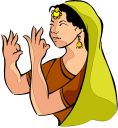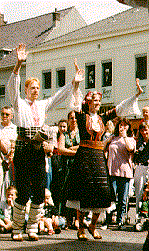 Music
and dance
Music and dance, both purely natural
arts, have gone hand in hand since the beginning of history. As
early as prehistoric times, people danced to the sound of music, played
or sung by their fellow men. In African tribes, one can see how music and
dance serve different social and ritual needs, from evoking rain, to banishing
demons and disease, war dances and holiday and wedding ceremonies.
On stage, the ancient Greeks were the first to institutionalise
the link between music and dance, and created a true combination of music
and ballet for purposes of the performance. Christianity, however, discarded
dance, because it was viewed as a pagan relic. Music
and dance
Music and dance, both purely natural
arts, have gone hand in hand since the beginning of history. As
early as prehistoric times, people danced to the sound of music, played
or sung by their fellow men. In African tribes, one can see how music and
dance serve different social and ritual needs, from evoking rain, to banishing
demons and disease, war dances and holiday and wedding ceremonies.
On stage, the ancient Greeks were the first to institutionalise
the link between music and dance, and created a true combination of music
and ballet for purposes of the performance. Christianity, however, discarded
dance, because it was viewed as a pagan relic.
 During
the era of Renaissance During
the era of Renaissance ,
as part of the general aspiration to revive the art of the ancient world,
plays, integrating dance, singing and dancing, were reintroduced, and these
plays were named "ballets" ,
as part of the general aspiration to revive the art of the ancient world,
plays, integrating dance, singing and dancing, were reintroduced, and these
plays were named "ballets" .
Ballet was dance's artistic side, whereas folk dances .
Ballet was dance's artistic side, whereas folk dances continued to develop, and it was during that period when the suite
continued to develop, and it was during that period when the suite emerged, which later became an important musical form, one of the
great influences on the music of the next centuries.
Ballet swept Europe, and its centre gradually moved from
Italy to France, where it was combined with theatre, mime art, mask-performances
and more. It became prestigious, and huge amounts of money were invested
in it. French ballet became an art with rules and customary methodology,
with no improvisation, and was based on scientific rules.
emerged, which later became an important musical form, one of the
great influences on the music of the next centuries.
Ballet swept Europe, and its centre gradually moved from
Italy to France, where it was combined with theatre, mime art, mask-performances
and more. It became prestigious, and huge amounts of money were invested
in it. French ballet became an art with rules and customary methodology,
with no improvisation, and was based on scientific rules.
 Lully Lully wrote a lot of music for ballets and presented women on stage for
the first time (until then such performance acts were considered "unchaste").
In the generation that succeeded Lully, Rameau
wrote a lot of music for ballets and presented women on stage for
the first time (until then such performance acts were considered "unchaste").
In the generation that succeeded Lully, Rameau was the most important figure in ballet music, and he was the one
who matched ballet with opera
was the most important figure in ballet music, and he was the one
who matched ballet with opera ,
as entertainment in the course of the story. ,
as entertainment in the course of the story.
 The
Romantic period The
Romantic period freed the ballet from the heavy outfits, and the "ballerina"
started claiming her place as the star of the ballet. Hovering, light,
dreamy figures - such were the ballerinas of the romanticism. The ballet
began its liberation from serving other arts and by the middle of the 19th
century, it would become an independent art-form. Russia
would then become the leading nation in the field, with composers such
as Tchaikovsky
freed the ballet from the heavy outfits, and the "ballerina"
started claiming her place as the star of the ballet. Hovering, light,
dreamy figures - such were the ballerinas of the romanticism. The ballet
began its liberation from serving other arts and by the middle of the 19th
century, it would become an independent art-form. Russia
would then become the leading nation in the field, with composers such
as Tchaikovsky ,
who wrote the music for the ballets "The Sleeping
Beauty", "Swan Lake" ,
who wrote the music for the ballets "The Sleeping
Beauty", "Swan Lake" and "Romeo and Juliet". In France,
at the same time, the audience demanded that the ballet be combined with
Opera always, and French composers spiced their operas with dances. Thus,
for instance, Offenbach
and "Romeo and Juliet". In France,
at the same time, the audience demanded that the ballet be combined with
Opera always, and French composers spiced their operas with dances. Thus,
for instance, Offenbach included dances from the clubs of Paris in his operettas (for example,
the famous "Kane-Kane" dance featured by a gallop
in "Orpheus"). Chopin's
included dances from the clubs of Paris in his operettas (for example,
the famous "Kane-Kane" dance featured by a gallop
in "Orpheus"). Chopin's "Sylaphides" ballet is one of the
most magical of his time (these are arranged themes from his waltzes, such
as the waltz in C#m
"Sylaphides" ballet is one of the
most magical of his time (these are arranged themes from his waltzes, such
as the waltz in C#m ).
Ravel ).
Ravel wrote the well known "Bolero"
wrote the well known "Bolero" for a ballet requisitioned by Ida Rubinstein.
The beginning of the 20th century
for a ballet requisitioned by Ida Rubinstein.
The beginning of the 20th century shifts the center of activity to Russia, and
especially to one important name in 20th century ballet - Sergey
Diaghilev, who requisitioned music from the greatest Russian composers
for his ballets. Stravinsky
shifts the center of activity to Russia, and
especially to one important name in 20th century ballet - Sergey
Diaghilev, who requisitioned music from the greatest Russian composers
for his ballets. Stravinsky wrote some of his most important works for Diagilev - "Firebird"
wrote some of his most important works for Diagilev - "Firebird" ,
"Petrushka" and "The
Rite of Spring" ,
"Petrushka" and "The
Rite of Spring" - among the most influential pieces in the 20th century. Composers like
Ravel
- among the most influential pieces in the 20th century. Composers like
Ravel ("Daphnis et Chloé")
and de Falla
("Daphnis et Chloé")
and de Falla ("The three-cornered hat") also
wrote, by his request, wonderful ballet music.
In his will, Stravinsky asked to be burried next to Diaghilev,
and that is proof of the friendship between the two of the most important,
fascinating men of the century. Armenian composer Khachatorian
("The three-cornered hat") also
wrote, by his request, wonderful ballet music.
In his will, Stravinsky asked to be burried next to Diaghilev,
and that is proof of the friendship between the two of the most important,
fascinating men of the century. Armenian composer Khachatorian introduced his own exotic elements into his ballets, among which are "Gian"
and "Spartacus".
In the second half of the 20th century, ballet turned
to fascinating new directions, and integrated electronic
music
introduced his own exotic elements into his ballets, among which are "Gian"
and "Spartacus".
In the second half of the 20th century, ballet turned
to fascinating new directions, and integrated electronic
music ,
pop music ,
pop music and jazz
and jazz . .
|
 Folk dances
Folk dances
|



